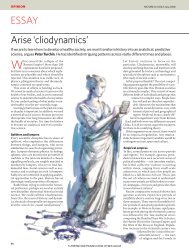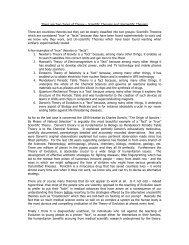The Science Studio With Rodolfo Llinás - The Science Network
The Science Studio With Rodolfo Llinás - The Science Network
The Science Studio With Rodolfo Llinás - The Science Network
You also want an ePaper? Increase the reach of your titles
YUMPU automatically turns print PDFs into web optimized ePapers that Google loves.
the external world by means other than nerves. Comma oh my god, closed<br />
parentheses, really. And I say yeah. <strong>The</strong> problem is that the brain is guarded by bone.<br />
I say in the book we have an exoskeleton when we talk about the brain. <strong>The</strong> rest, the<br />
muscles are out and so on, so ok. If a) the brain were to, if the cranium were to be<br />
transparent, we could see the activity of the brain, instead of looking at people’s faces,<br />
you would look at people’s brains and say don’t think that. You could see the patterns<br />
and say no, no, don’t take it like that. <strong>The</strong> same thing happens when somebody tells<br />
you that they’re not agreeing with you.<br />
Imagine that in addition to doing like that, you could say well what if I actually<br />
communicate with you directly so we don’t have to go through all this blabbering or<br />
this talking and I’ll tell you exactly how I feel. How could I do it in principle? Well I<br />
could go directly to the brain. <strong>The</strong> problem is, oh my god, but you have to then<br />
penetrate this bone. So thinking about how could we do it, is well, the brain is full of<br />
holes, don’t make any new ones. And what are the holes I’m thinking about? <strong>The</strong><br />
vascular system. So imagine. <strong>The</strong> blood vessels, right. Imagine yourself becoming<br />
very small in this beautiful whole film- science fiction, into the vessels and you go into<br />
the brain. Where can you go? Anywhere. <strong>The</strong> brain is completely vascularized. It’s<br />
full of these vessels and they occur every 15 microns, it’s a 3-dimensional scaffolding<br />
that goes everywhere. And then the question is, don’t go to the brain through the<br />
outside, go to the brain through the inside. Why not put a wire up to anywhere you<br />
want in the brain and try to record or stimulate or both. But it has to be a very thin<br />
wire because you don’t want it to bother circulation. It has to be of such material that<br />
it’s not recognized by the body as being there. Can this be done? <strong>The</strong> answer is yeah,<br />
there are ways to protect the wire from being…<br />
BINGHAM: You’re right, this does sound like science fiction and the utility would be<br />
what?<br />
LLINÁS: <strong>The</strong> utility would be…. <strong>The</strong> utility would be as follows. At this moment we<br />
are getting to about a 30 nanometer wire. It is a third of a micron- a micron being very<br />
small- thousandths of a millimeter. You can put several hundred in the diameter of a<br />
single hair. Ok so you float this thing, say you want to do more than one, you want to<br />
do ten or a hundred or a thousand or ten thousand or however many, so you can wire<br />
the brain from the inside. What can you do? Two things, you can record and you can<br />
stimulate. Ok so you have something in front of you about your brain or in front of<br />
you about somebody else’s brain, heaven forbid, with the ability to address the brain.<br />
What is the first thing you do? Well you probably instead of doing electrical<br />
stimulation of the top, you’ll do it to the vessel.<br />
Now is this done? <strong>The</strong> answer is, it is done every day in neurosurgery for other<br />
reasons. <strong>The</strong> people who do that are called interventional neuroradiologists and they<br />
put in things that go around and let go little objects that would close a vessel that has<br />
an aneurysm or something. You correct, this is things that people know how to do






